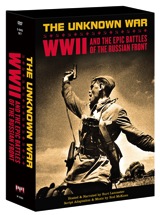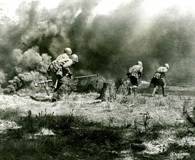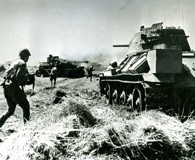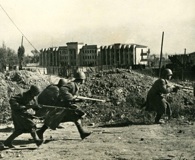 The Unknown War: WWII and the Epic Battles of the Russian Front. Five-DVD boxed set. Shout! Factory. $39.95.
The Unknown War: WWII and the Epic Battles of the Russian Front. Five-DVD boxed set. Shout! Factory. $39.95.
Fighting in a land without end. Tank battles and urban warfare fought on an unimaginable scale. Sweeping maneuvers and desperate defensive stands. Staggering casualty totals, both military and civilian.
That was World War II, as fought between Nazi Germany and the Soviet Union, a struggle still known in the former USSR as The Great Patriotic War. Today, many Americans have seen programs about the German–Soviet clash on History, The Military Channel, PBS and other networks. But for decades after World War II, the average American knew very little about events on Europe’s Eastern Front—which is why a 1978 television documentary was titled The Unknown War: WWII and the Epic Battles of the Russian Front. It originally ran on American television in 1978 but vanished from the airwaves after the Soviet Union invaded Afghanistan in 1979.
Now, this extensive documentary is about to be released as a twenty-episode, five-DVD boxed set on May 24, 2011, and its 16+ hours of World War II footage is well worth watching. Soviet photographers went to war as soldiers, so many of the combat scenes are up-close and personal.
 The original program was made in reaction to the renowned 1973–74 BBC documentary The World at War. Soviet officials felt that program did not properly represent their country’s significant role in World War II, so they made available extensive archival film footage—much of it still rarely seen today—for creating The Unknown War. Creating the program required a level of Soviet–American cooperation unusual during the Cold War. American film crews were given access to shoot within the Soviet Union, and that allows Western viewers to see many of the Soviet monuments to the war. The series’ narrator, Academy Award®–winner Burt Lancaster, often introduces episodes while standing by one of these monuments. German films are also interspersed throughout the series.
The original program was made in reaction to the renowned 1973–74 BBC documentary The World at War. Soviet officials felt that program did not properly represent their country’s significant role in World War II, so they made available extensive archival film footage—much of it still rarely seen today—for creating The Unknown War. Creating the program required a level of Soviet–American cooperation unusual during the Cold War. American film crews were given access to shoot within the Soviet Union, and that allows Western viewers to see many of the Soviet monuments to the war. The series’ narrator, Academy Award®–winner Burt Lancaster, often introduces episodes while standing by one of these monuments. German films are also interspersed throughout the series.
The 20 episodes begin with “June 22, 1941.” Soviet citizens stroll through Moscow and elsewhere, shopping and doing other mundane activities, blissfully unaware of the tidal wave of destruction rolling their way. Such peaceful scenes give way to footage of German columns motoring and marching eastward, leaving corpses and burning buildings in their wake.
Subsequent episodes include the battles for Moscow, Leningrad and Stalingrad, as well as the fighting in the Caucasus and what is often described as the largest tank battle in history, the Battle of Kursk. The footage is compelling: residents of Leningrad dragging sleds with bodies on them; soldiers crawling through the rubble of Stalingrad as shells burst in buildings nearby; masses of tanks attacking at Kursk.
What lifts this 1978 series above a mere retelling of the better-known battles are episodes such as “The War in the Air,” “The Battle of the Seas,” “Partisans: The Guerilla War,” “War in the Arctic ” and “From the Balkans to Vienna.”
The episode “A Soldier of the Unknown War” examines the sacrifices made by Soviet soldiers and civilians to throw back the fascist invaders. “To the East” tells the story of how factories were rapidly dismantled and moved beyond the reach of German bombers; it mentions the activities of young Leonid Brezhnev, future general secretary of the Communist Party (1964–1982). Alexei Kosygin, a coordinator of the factories’ resettlement and premier of the USSR 1964–1980, talks on-camera about the massive effort required to move Soviet industry.
A particularly nifty surprise within the series is “The Last Battle of the Unknown War,” the Soviet war against Japan in the summer of 1945, a topic that gets very little coverage in the West.
 Tread-heads and gear-geeks will have a field day spotting all the different types of equipment. (Were those BT-35 land battleships? Is that guy carrying an anti-tank rifle?) Viewers who relate more to the personal stories that come out of war will find ample examples of courage, loss, grief and triumph as well, some of them told by the people who lived through them.
Tread-heads and gear-geeks will have a field day spotting all the different types of equipment. (Were those BT-35 land battleships? Is that guy carrying an anti-tank rifle?) Viewers who relate more to the personal stories that come out of war will find ample examples of courage, loss, grief and triumph as well, some of them told by the people who lived through them.
One particularly poignant scene deals with the defiant performance of Dimitri Shostakovich’s Symphony No. 7 (the Leningrad Symphony) by the Leningrad orchestra during the city’s 900-day siege. The same piece was performed a generation later in the same theater, using only surviving musicians from the original performance, playing only for surviving members of the original audience. The camera pans past empty chair after empty chair, silent testimony to the high death rate among civilians.
The greatest weakness of the production is what is left out of its narration. The Soviet government and military’s atrocities against its own citizens and others are glossed over or go unmentioned, such as the war with Finland and the treatment of anyone—even entire ethnic groups—suspected of collaborating with the Germans. In an extra feature Willard Sunderland, associate professor of Russian history at the University of Cincinnati, provides a more balanced analysis of the film and some of the events depicted in it.
One episode is even titled “The Liberation of Poland.” No mention is made, of course, that in Poland and the rest of Eastern Europe the end of fascist control simply meant the installation of communist dictatorships. To bring up those unpleasantries would have been “politically incorrect”—and would have ended Soviet participation in the project, which would have denied Western audiences the chance to see this phenomenal amount of rare film footage.
In a way, the original film’s unstinting praise for the USSR’s war effort actually adds to the program’s period atmosphere. For the duration of World War II, “our brave Soviet allies,” were described in glowing terms in Western news reports, and American citizens were urged to attend pro-Soviet rallies.
 That attitude ended about 30 seconds after the war did, but the narration in The Unknown War gives a sense of how “the Russians” were depicted when they were our allies, and for the same reason—to insure their cooperation in a mutual effort. In this case, that cooperation resulted in a monumental documentary on an often-ignored or under-represented subject. Visually, this is a landmark documentary; just keep a saltshaker handy for taking the narration with a grain of salt.
That attitude ended about 30 seconds after the war did, but the narration in The Unknown War gives a sense of how “the Russians” were depicted when they were our allies, and for the same reason—to insure their cooperation in a mutual effort. In this case, that cooperation resulted in a monumental documentary on an often-ignored or under-represented subject. Visually, this is a landmark documentary; just keep a saltshaker handy for taking the narration with a grain of salt.
The Unknown War is compelling and informative, and its often-haunting soundtrack—newly re-mastered for this DVD set by its composer Rod McKuen and performed by the London Royal Philharmonic Orchestra, the USSR Bolshoi Symphony Orchestra, the Soviet Army Choir and McKuen himself—greatly enhances the film footage. (Shout! Factory, which produced the DVD version of the documentary, is offering a free copy of the newly remastered soundtrack with consumer orders placed directly through the ShoutfactoryStore.com.) Extra features include an interview with McKuen, who also did the script adaptation, discussing how this Soviet-American coproduction came about.
The DVD box set of The Unknown War will also be available in retail and online outlets May 24.
To view video clips from the program, click on the links below.
Opening sequence
http://www.youtube.com/watch?v=r9pwhGnJnf8
Combat footage
http://www.youtube.com/watch?v=yqJ7hy8tcks
Yugoslav partisans
http://www.youtube.com/watch?v=1_yE3wFiFHo
About the Author:
Gerald D. Swick is senior online editor for World History Group.




